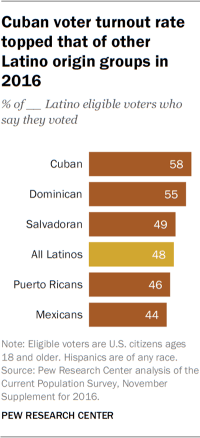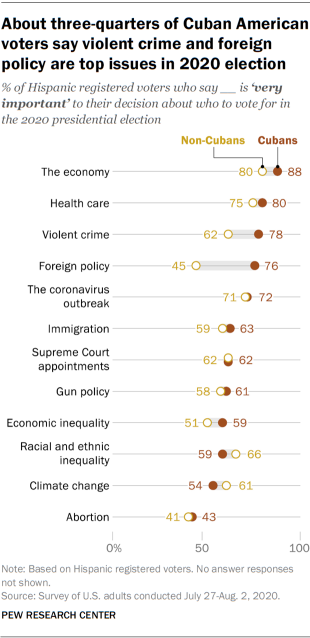Unlike other Hispanic registered voters in the United States, most Cuban Americans identify as Republican – a pattern that could have electoral implications as President Donald Trump seeks to recapture the important swing state of Florida this year.
Nationwide, 58% of Cuban registered voters say they affiliate with or lean toward the Republican Party, while 38% identify with the Democratic Party or lean Democratic, according to a Pew Research Center survey conducted July 27-Aug. 2. By comparison, around two-thirds of Hispanic voters who are not Cuban (65%) identify as or lean Democratic, while 32% affiliate with the Republican Party.
Historically, Cuban Americans have backed the Republican Party in large numbers, but that support has at times softened as a new generation of U.S.-born, Democratic-leaning Cubans has come of age. In 2013, similar shares of Cuban registered voters identified with the Republican Party (47%) and the Democratic Party (44%). That same year, 60% of non-Cuban Hispanic voters identified as Democratic and 28% as Republican.
Pew Research Center asked these questions on a recent survey to understand American voters’ attitudes toward the 2020 presidential election and campaign, and their views of the nation’s response to the coronavirus outbreak. For this analysis, we conducted an online survey of 11,001 U.S. adults, including 1,652 Hispanic registered voters and 543 Cuban American registered voters, between July 27 and Aug. 2, 2020. The Cuban American sample in this survey is more heavily concentrated in Florida than the Cuban American population.
Everyone who took part is a member of the Center’s American Trends Panel (ATP), an online survey panel that is recruited through national, random sampling of residential addresses. This way nearly all U.S. adults have a chance of selection. The survey is weighted to be representative of the U.S. adult population by gender, race, ethnicity, partisan affiliation, education and other categories. Read more about the ATP’s methodology.
Here are the questions used for this report, along with responses, and its methodology.
As of 2018, the U.S. was home to 1.4 million Cuban eligible voters – defined as adult U.S. citizens – according to a Center analysis of U.S. Census Bureau data. Most (55%) were naturalized citizens who were born outside the U.S., and 65% lived in Florida. In 2018, Cubans (29%) and Puerto Ricans (27%) accounted for the largest Hispanic eligible voter populations in Florida, reflecting a Hispanic electorate in the state that has grown more diverse over the decades. The Cuban share was down from 49% in 1980.
Cubans in Florida have helped make the state’s Latino vote different from that of the nation overall. In 2016, 54% of Cubans in Florida voted for Donald Trump, compared with 35% of the state’s Latino voters overall and 28% of Latinos nationwide, according to exit polls. (A Pew Research Center study of the 2016 electorate based on validated voters found similar voting patterns among Latinos nationwide.)
Turnout among Cuban Americans has regularly been one of the highest among Hispanic eligible voter groups. In 2016, 58% of Cubans voted, compared with 55% of Dominicans, 49% of Salvadorans, 46% of Puerto Ricans and 44% of Mexicans, according to an analysis of Census Bureau data. The voter turnout rate for Latino eligible voters overall was 48%.
Since taking office in 2017, Trump has imposed several sanctions on Cuba, including restrictions on trade, travel and remittances, reversing the Obama administration’s expansion of diplomatic and economic ties with the island nation. By contrast, Democratic presidential candidate Joe Biden has said he would largely restore Obama-era policies toward Cuba.
Cuban American voters and the 2020 presidential election
Cuban American registered voters have mixed views of Trump heading into the November elections. About half (52%) say they approve of the way Trump is handling his job as president, while 45% disapprove. By comparison, only 26% of non-Cuban Hispanic voters approve of Trump and 70% disapprove. Trump’s ratings among these groups are nearly identical to those in a December 2019 national survey of Latino adults, taken before the coronavirus outbreak.
Cuban voters’ assessments of Trump are deeply polarized along party lines: 81% of Cuban Republicans approve of Trump, while 91% of Cuban Democrats disapprove of the president. Trump’s approval ratings are similarly partisan – and stable – among U.S. voters overall.
Most Cuban American registered voters say they are tuned in to the 2020 presidential campaign. Three-quarters (75%) say they have given a lot or some thought to the candidates running for president, with similar shares of Republicans and Democrats saying so.
Among Cuban voters, the prospect of a Trump victory provokes stronger reactions – both positive and negative – than the prospect of a Biden victory. About one-in-five Cuban voters (19%) say they would feel excited if Trump was reelected, and an equal share (19%) say they would feel angry. Another 34% say they would feel relieved by a Trump victory, while 26% would feel disappointed. By contrast, only 10% of Cuban voters say they would feel excited if Biden was elected, and 12% say they would feel angry. Meanwhile, 34% would feel relieved and 41% would feel disappointed by a Biden win.
The vast majority of Cuban American registered voters say the issues of the economy (88%) and health care (80%) are very important to their vote for president in 2020, the highest shares among the 12 issues included in the survey. While Cubans hold similar views to non-Cuban Hispanics (and U.S. Hispanics overall) on the importance of these two issues, the groups have different views in some areas. Most notably, a far higher share of Cuban voters than non-Cuban Hispanic voters say foreign policy is very important, 76% vs. 45%, reflecting in part the close immigrant ties many Cuban Americans have to the island. Cuban and non-Cuban Hispanic voters also differ on the importance of the issue of violent crime in their vote for president (78% vs. 62%).
Note: Here are the questions used for this report, along with responses, and its methodology.







